

Co-directors Vito Messina (CST) and Jafar Mehrkian (ICAR)
|
Fig 1. - The
valley of Hung-e Azhdar Click to enlarge 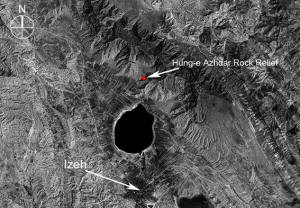 The Iranian-Italian Joint Expedition in Khuzistan
started work in the area of Hung-e Azhdar, a small village located at the entrance of a
valley in the Bakhtiari Plateau, about 17 km north of the modern city of
Izeh (Fig. 1). This project has been developed within the framework of a
Memorandum of Understanding, signed between the Iranian Center for
Archaeological Research (ICAR) of the
Cultural Heritage, Common Handicrafts and Tourism Organization of the
Islamic Republic of Iran (ICHTO) and the Centro Ricerche Archeologiche e
Scavi di Torino per il Medio Oriente e l’Asia (CST).
Other institutions involved in the project, as partners of the CST, were
the Dipartimento di Ingegneria del Territorio, dell’Ambiente e delle
Geotecnologie del Politecnico di Torino (DITAG), and the Dipartimento di
Scienze Antropologiche, Archeologiche e Storico-Territoriali
dell’Università di Torino (SAAST).
The Iranian-Italian Joint Expedition in Khuzistan
started work in the area of Hung-e Azhdar, a small village located at the entrance of a
valley in the Bakhtiari Plateau, about 17 km north of the modern city of
Izeh (Fig. 1). This project has been developed within the framework of a
Memorandum of Understanding, signed between the Iranian Center for
Archaeological Research (ICAR) of the
Cultural Heritage, Common Handicrafts and Tourism Organization of the
Islamic Republic of Iran (ICHTO) and the Centro Ricerche Archeologiche e
Scavi di Torino per il Medio Oriente e l’Asia (CST).
Other institutions involved in the project, as partners of the CST, were
the Dipartimento di Ingegneria del Territorio, dell’Ambiente e delle
Geotecnologie del Politecnico di Torino (DITAG), and the Dipartimento di
Scienze Antropologiche, Archeologiche e Storico-Territoriali
dell’Università di Torino (SAAST).
|
Members of the Expedition were Mr. Jafar Mehrkian (ICAR, archaeologist and co-director), Mr. Mehdi Faragi (ICAR, archaeologist), Mrs. Yalda Sourani (ICAR, architect), and Mr. Mogtaba Shokrollahi (photographer), for the Iranian side; Mr. Vito Messina (CST–SAAST, archaeologist and co-director), Mr. Claudio Fossati (SAAST, architect and draughtsman), Mr. Paolo Ardissone (DITAG, archaeologist and topographer), and Mrs. Cristina Bonfanti (DITAG, architect), for the Italian side.
The aim of the Expedition was the acquisition by laser scanning of a Parthian rock relief, depicting a scene of homage or investiture (?), and carved on the surface of a large boulder close to the southern slopes of the mountain surrounding the Hung-e Azhdar valley. This relief is on the hidden side of the boulder –namely the side facing the mountain–, and is about 5.40 m long and 2.10 m high, while its lower edge is about 1.50 m from the soil. The sculpted surface covers about 11 m2 and ranges from about 1 to 15 cm in depth.
A second relief showing a procession in two registers, smaller than the Parthian relief, is carved on the opposite side of the same boulder (that facing the valley): its surface is very damaged and the upper register eroded, but the scene in the lower register –seven (?) figures in profile proceeding to left, toward a seated figure (?)– seems to date from the Middle or the Neo-Elamite Period (about 15th-7th century BC).
![]()
View this report in Adobe Reader (PDF) format.
The Parthian relief (Fig. 2) shows a bearded horseman followed by an attendant, in the left half of the scene, and four standing men on the right (see e.g. Vanden Berghe, 1963, 155-168 and Id., 1984, 120-121; Von Gall, 1969-70, 301-302; Schlumberger, 1970, 40-41; De Waele, 1975, 60; Downey, 1977, 285; Harmatta, 1981, 200-219; Vanden Berghe, Schippmann, 1985, 32-38; Mathiesen, 1985, 191-196 and Id., 1992, 119-121; Kawami, 1987, 209-213; Invernizzi, 1998, 219-259). The horseman and his attendant are shown in profile, while the standing men are in a frontal pose. Two small eagles (?) with outspread wings fly toward the horseman and the central figure, holding a wreath or a ring: the bird flying toward the horseman holds this object with its claws, the bird flying toward the central figure holds it in its beak.
This rock relief is of special interest within the art of ancient Elymais, since the iconography and the style of the figures in the scene are very different: whilst the four standing men in the right half of the relief are depicted in a frontal position and in Iranian dress, the horseman and his attendant in the left half are the only figures among the whole set of Parthian rock reliefs to be depicted in profile. The horseman is even portrayed in the manner of a Hellenistic or an early Parthian sovereign, with short hair on his head and a long diadem tied at the nape with fluttering ends. The carving, too, seems different in the two halves of the scene, the horseman being sculpted in higher relief than the standing men.
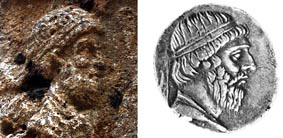 Fig. 3 - The
horseman head compared with a coin portrait of Mithradates I
Fig. 3 - The
horseman head compared with a coin portrait of Mithradates I
Because of these contradictions, the chronology and the interpretation of the scene are still under discussion and many questions have been raised regarding the presence of so different iconographies. By comparison with coin portraits (Fig. 3), the horseman has been interpreted by many scholars as the Parthian king Mithradates I (141-138 BC), honoured by an Elymaean sovereign –Kamnaskires I (?)– and his retinue (Vanden Berghe, 1963, 155-168 and Id., 1983, 120-121; Schlumberger, 1970, 40-41; Vanden Berghe, Schippmann, 1985, 36; Mathiesen, 1992, 120). This interpretation is not quite certain and, according to other scholars (Invernizzi, 1998, 234-241), the horseman could be even identified as the Seleucid ruler Demetrius II (first reign 146-138 BC; second reign 129-125 BC). However, the horseman is generally considered as a production of the second half of the 2nd century BC (for the Hellenistic-early Parthian chronology of the horseman see Von Gall, 1969-70, 308; Schlumberger, 1970, 40; De Waele, 1975, note 2; Vanden Berghe, 1983, 120; Mathiesen, 1992, 120). This date is in contrast with the figures in the right half of the relief, executed in a frontal attitude and lined up in the paratactic manner which is generally considered characteristic of a much later period, starting from the 1st-3rd century AD (on the basis of stylistic criterions, Kawami, 1987, 124, is convinced that the relief is to be dated to the late 2nd or the beginning of the 3rd century AD. Invernizzi, 1998, 258, prefers a wider range, between the 1st and the 3rd century AD). This contradiction leads to debate whether the represented figures have been sculpted at different times, possibly after centuries, or during the same period by sculptors of different school (still influenced by the Hellenistic tradition the sculptor of the horseman and of his attendant, fully Iranian the sculptor of the standing men presented frontally). These different interpretations completely change the historical framework of the sculpture and of the commission of the relief: the Hellenistic or early Parthian chronology allows to place the execution of the scene –or, at least, of the horseman and his attendant– within the conquest of Elymais made by Mithradates I in 140-139 BC, or rather in the following decades; by contrast the late Parthian chronology (2nd-3rd century AD) seems to refer to a production –or to an addition (?)– at the request of a local ruler (Mathiesen, 1992, 121).
The Hung-e Azhdar rock relief has been already surveyed with traditional methods in the past years. These researches provided a number of photographs and drawings which, even when of high quality, do not allow for a more in-depth examination.
For this reason, the present project aimed to increase information by the use of a laser scanner. This technology can allow to conduct a detailed examination of the sculpted surface and a precise measurement of the carving’s depth in different points of the scene, and so shed new light on the carving techniques of all the represented figures. The erosion of the surface could also be detected, updating the acquired information with further periodic scanning, in order to make comparison with previous data.
The acquisition by laser scanning lasted 8 days. The sculpted surface of the boulder has been divided into 34 squared sectors, each of 60x60 cm (Fig. 4). About 15,000 markers were placed on the surface, at a distance of no more than 5 cm one from the other, in order to allow the scanner to recognize its position in a 3D model (Fig. 5). These markers are circular spots, with a diameter of about 5 mm, that have been completely removed after acquisition. Each sector has been separately scanned with a high definition Handyscan 3D (model HZ), a self-positioned hand-held scanner perpendicularly moved at about 15-20 cm from the rock surface (Fig. 6): 34 frames have been acquired as digital files at the highest resolution (1,95 mm), and an overlap band has been saved between adjacent sectors, with a 10% tolerance. The scanner never touched the surface during operation.
|
Fig. 6 - Operating laser scanner and acquired data |
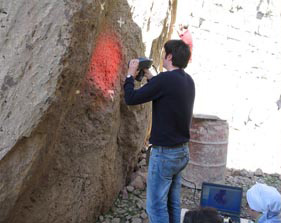
|
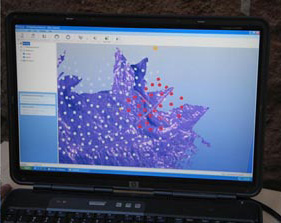
|
| Photos by V. Messina |
Vertices have been located on the ground by a GPS receiver (model Topcon Hiper PRO) and by traditional topographic method, while 70 ground control points, placed on the sculpted surface (Fig. 8), have been located by a total station (model Topcon Get 3005N), in order to define a network for further topographic surveys. This network has 4 main vertices, while the ground control points have been collimated for orientating the frames acquired by the laser scanner and the digital photogrammetric camera.
This allowed to relate the numerical and tridimensional nature of the acquired information to a known reference system. The accuracy of the grid has been verified by triangulation of each vertex, and intersections of the ground control points have been measured from 2 vertices (Fig. 9).
|
Fig. 9 - Intersections of the ground control points on the sculpted surface |
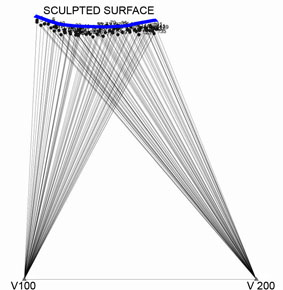
|
The acquired frames have been merged and elaborated in the laboratory of the DITAG, and allowed to create a 3D digital model of the rock relief consisting in 7.692.104 points, with an accuracy of 0.2 mm approximately (Fig. 10). The images acquired by the digital photogrammetric camera have been elaborated to obtain a digital orthophoto (Fig. 11) and “Solid Images” of the scanned surface. Solid Images are digital images where all pixels contain x, y and z coordinates, providing information in a known reference system, so that it is possible to measure angles, distances and areas. These are high resolution RGB files (non orthorectified), integrated by a numerical matrix of the same resolution, containing tridimensional data of the scanned surface.
|
Fig. 10a - SirIO 3D model of the Hung-e Azhdar rock relief |
|
Fig. 10b - SirIO 3D models of the Hung-e Azhdar rock relief |
Fig. 11 - SirIO Orthopho of the Hung-e Azhdar rock relief |
| Photos: elaboration DITAG |
A specific software (SirIO) has been created for the analysis of these data. This software allows to manage all the elaborated files –the 3D model, the orthophoto and solid images– on a unique digital platform: traces of tools on the sculpted surface, differences in the depth of the carving, and the natural conformation of the rock have to be examined in order to verify whether in the two halves of the sculpted scene, besides the evident contradictions in iconography and style, there are also differences in the carving technique and evidence of re-sculpting.
|
Fig. 12 - SirIO merging sections |
|
Fig. 13 - SirIO drawing section |
Fig. 14 - SirIO elaborating coordinates |
| Photos: elaboration DITAG |
The software SirIO edits the numerical matrix as graphic layers, merging all the acquired information on the same support. Sections of the whole scanned surface can be drawn on the 3D model and on solid images (Figs 12 and 13), and coordinates could be elaborated in a 3D reference system (Fig. 14). Distances can be measured in millimetres, in all directions (Fig. 15), and all the new layers can be exported as *.dxf files, in order to manage them with AutoCAD. Graphic layers can also be edit as equations (Fig. 16).
Fig. 15 - SirIO measuring distance
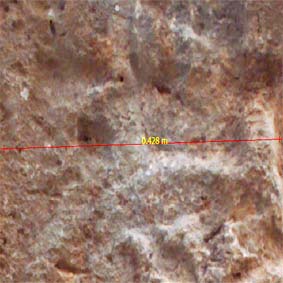 |
| Photos: elaboration DITAG |
In addition to the problems related to the technique and the style of the figures in the scene, the reason why the relief was sculpted on an isolated boulder close to the mountain, on its hidden side, as if it had to pass unobserved, still remains an open question, and because of the lack of no detailed surveys in the Hung-e Azhdar valley, a preliminary archaeological survey of the surrounding area was also planned, with the purpose of discovering traces of further archaeological remains.
A small area of about 4.400 m2, very close to the boulder carrying the reliefs, has been surveyed, revealing the presence of pottery, broken in sherds, and very few fragments of bones, gathered with rubble in small groups of different size. These groups surround the boulder in all direction: they have irregular shape and seem to belong to a disturbed archaeological context. At least 19 small groups of sherds and rubble have been recognized. Groups 1, 2 and 3 are very close one another and are located about 33 m south-westward from the boulder. Group 1 extends for about 18 m2 between two stones: very few fragments of bones were visible on the ground, mixed with sherds and rubble; Group 2 is located between Groups 1 and 3, westward from Group 1, and has the same extent: it consists of sherds and rubble; Group 3 seems delimitated by small stones in the shape of an irregular circle, extending for about 20 m2: a large number of sherds were visible on the ground. Group 4 is very small, extending for 5 m2 northward from Groups 1, 2 and 3. Group 5 is located about 36 m westward from the boulder and extends for about 5 m2: here sherds are scanty in comparison with rubble. Groups 6, 7 and 11 are located about 13 m northward from the boulder: they have the roughly circular shape of Group 3 but are smaller, each one extending for about 9 m2. Groups 8, 9 and 10 are partly merged one into another; they extend for about 12 m2 and are located about 23 m northward from the boulder: sherds are scanty in all groups, while few fragments of bones were visible at least in Groups 8 and 10. Not faraway is Group 13, extending for about 16 m2. Group 12 is at the foot of the boulder, toward the valley, and extends for about 4 m2: here the sherds are scanty and mixed together with few beads. Groups 14, 15 and 16 are located about 22 m eastward from the boulder, on a small terrace at the foot of the mountain: they extend for about 30 m2 and consist of a large number of sherds and rubble. Groups 17, 18 and 19 extend for about 35 m2. They are located no more than 4 m from the sculpted surface of the boulder facing the mountain –the surface with the Parthian relief–, on a low terrace delimited by boulders of different size: here sherds and few beads were visible on the ground.
These groups have been located on the ground in a known reference system by the total station. Neither sherds nor other artefacts have been collected. Further sherds have also been discovered, scattered on the whole surveyed area. The presence of pottery, broken in sherds, and of fragments of bones reveals the archaeological interest of the valley, that demand further investigation.
De Waele, E.
1975, “La sculpture rupestre d’Elymaïde. Deux fragments
inédits d’époque parthe”, Revue d’Assyriologie et d’Archéologie orientale, 69,
p. 59-79.
Downey, S. B.
1977, The stone and plaster sculpture, (Excavations at
Dura-Europos, Final Report, III, I.2), Los Angeles.
Harmatta, J.
1981, “Parthia and Elymais in the 2nd century BC”, Acta
Antiqua Academie Scientiarum Hungaricae, 29, p. 189-217.
Invernizzi, A.
1998, “Elymaeans, Seleucids, and the Hung-e Azhdar Relief”,
Mesopotamia, 33, p. 219-259.
Kawami, T. S.
1987, Monumental Art of the Parthian Period in Iran, (Acta
Iranica, 26), (Textes et Mémoires, XIII), Leiden.
Mathiesen, H. E.
1985, “A note on the dating of the Parthian rock relief
at Hung-i Nauruzi”, Acta Archaeologica, 56, p. 191-196.
1992, Sculpture in
the Parthian Empire. A Study in Chronology, I-II, Aarhus.
Schlumberger, D.
1970, L’Orient hellénisé. L’art grec et ses héritiers
dans l’Asie non Méditerranéenne, Paris.
Schmidt, E. F.
1970, Persepolis, III,
The royal tombs and other monuments, (Oriental Institute Publications, 70),
Chicago.
Vanden Berghe, L.
1963, “Le relief parthe de Hung-i Naurūzī”, Iranica Antiqua, 3, p. 155-168.
1984,
Reliefs rupestres de l’Irān ancien, Bruxelles.
Vanden Berghe, L., Schippmann, K.
1985, Les reliefs rupestres d’Elymaïde
(Iran) de l’époque parthe, (Iranica Antiqua Supplement, III), Gent.
Von Gall, H.
1969-70, “Beobachtungen zum arsakidischen Diadem und zur
parthischen Bildkunst”, Istanbuler Mitteilungen, 19-20, p. 299-318.
This page last updated 12 Mar 2021